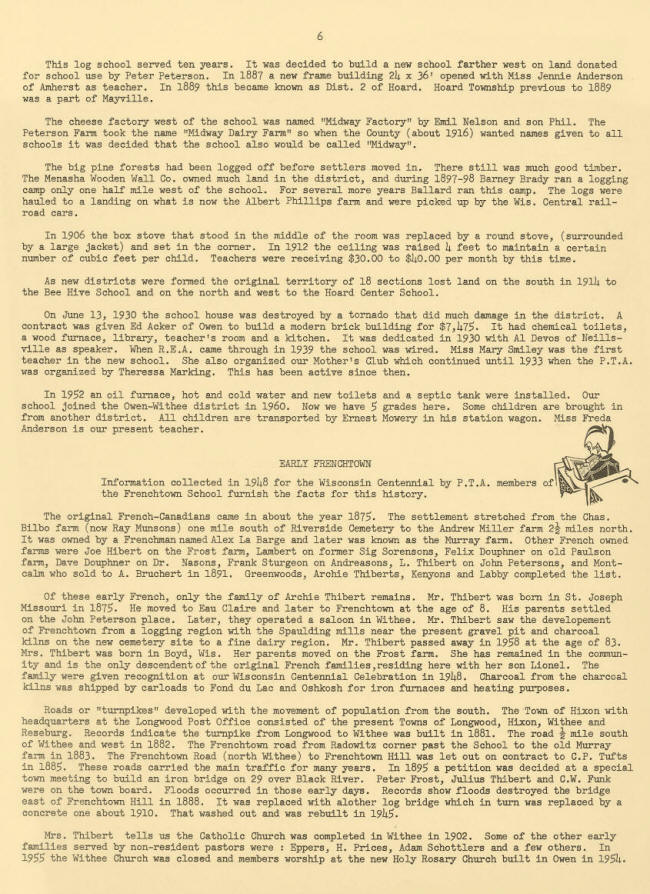|
[Memory
Trails Index]
Transcription
Janet Schwarze
This log school served
ten years. It was decided to build a new school farther west on land donated for
school use by Peter Peterson. In 1887 a new frame building 2)4 x 36’ opened with
Miss Jennie Anderson of Amherst as teacher. In 1889 this became known as Dist. 2
of Hoard. Hoard Township previous to 1889 was a part of Mayville.
The cheese factory west of the school was named “Midway Factory” by Emil Nelson
and son Phil. The Peterson Farm took the name “Midway Dairy Farm” so when the
County (about 1916) wanted names given to all schools it was decided that the
school also would be called “Midway”.
The big pine forests had been logged off before settlers moved in. There still
was much good timber. The Menasha Wooden Wall Co. owned much land in the
district, and during 1897-98 Barney Brady ran a logging camp only one half mile
west of the school. For several more years Ballard ran this camp. The logs were
hauled to a landing on what is now the Albert Phillips farm and were picked up
by the Wis. Central railroad cars.
In 1906 the box stove that stood in the middle of the room was replaced by a
round stove, (surrounded by a large jacket) and set in the corner. In 1912 the
ceiling was raised )4 feet to maintain a certain number of cubic feet per child.
Teachers were receiving $30.00 to $40 per month by this time.
As new districts were formed the original territory of 18 sections lost land on
the south in 1914 to the Bee Hive School and on the north and west to the Hoard
Center School.
On June 13, 1930 the school house was destroyed by a tornado that did much
damage in the district. A contract was given Ed Acker of Owen to build a modern
brick building for $7,475. It had chemical toilets, a wood furnace, library,
teacher’s room and a kitchen. It was dedicated in 1930 with Al Devos of
Neillsville as speaker. When R.E.A. cane through in 1939 the school was wired.
Miss Mary Smiley was the first teacher in the new school. She also organized our
Mother’s Club which continued until 1933 when the P.T.A. was organized by
Theressa Marking. This has been active since then.
In 1952 an oil furnace, hot and cold water and new toilets and a septic tank
were installed. Our school joined the Owen-Withee district in 1960. Now we have
5 grades here. Some children are brought in from another district. All children
are transported by Ernest Mowery in his station wagon. Miss Freda Anderson is
our present teacher.
EARLY FRENCHTOWN
Information collected in 19)48 for the Wisconsin Centennial by P.T.A. members of
the Frenchtown School furnish the facts for this history.
The original French—Canadians cane in about the year 1875. The settlement
stretched from the Chas. Bilbo farm (now Ray Munsons) one mile south of
Riverside Cemetery to the Andrew Mifler farm 2* miles north. It was owned by a
Frenchman named flex La Barge and later was known as the Murray farm. Other
French owned farms were Joe Hibert on the Frost farm, Lambert on former Sig
Sorensons, Felix Douphner on old Paulson farm, Dave Douphner on Dr. Nasons,
Frank Sturgeon on Andreasons, L. Thibert on John Petersons, and Mont- calm who
sold to A. Bruohert in 1891. Greenwoods, Archie Thiberts, Kenyons and Labby
completed the list.
Of these early French, only the family of Archie Thibert remains. Mr. Thibert
was born in St. Joseph Missouri in 1875. He moved to Eau Claire and later to
Frenchtown at the age of 8. His parents settled on the John Peterson place.
Later, they operated a saloon in Withee. Mr. Thibert saw the development of
Frenchtown from a logging region with the Spaulding mills near the present
gravel pit and charcoal idlus on the new cemetery site to a fine dairy region.
Mr. Thibert passed away in 1958 at the age of 83. Mrs. Thibert was born in Boyd,
Wis. Her parents moved on the Frost farm. She has remained in the community and
is the only descendent of the original French families, residing here with her
son Lionel. The family were given recognition at our Wisconsin Centennial
Celebration in 1948. Charcoal from the charcoal kilns was shipped by carloads to
Fond du Lao and Oshkosh for iron furnaces and heating purposes.
Roads or “turnpikes” developed with the movement of population from the south.
The Town of Hixon with headquarters at the Longwood Post Office consisted of the
present Towns of Longwood, Hixon, Withee and Reseburg. Records indicate the
turnpike from Longwood to Withee was built in 1881. The road * mile south of
Withee and west in 1882. The Frenchtown road from Radowitz corner past the
School to the old Murray farm in 1883. The Frenchtown Road (north Withee) to
Frenchtown Hiil was let out on contract to C. P. Tufts in 1885. These roads
carried the main traffic for many years. In 1895 a petition was decided at a
special town meeting to build an iron bridge on 29 over Black River. Peter
Frost, Julius Thibert and C. W. Funk were on the town board. Floods occurred in
those early days. Records show floods destroyed the bridge east of Frenchtown
Hill in 1888. It was replaced with alother log bridge which in turn was replaced
by a concrete one about 1910. That washed out and was rebuilt in 1945.
Mrs. Thibert tells us the Catholic Church was completed in Withee in 1902. Some
of the other early families served by non-resident pastors were Eppers, H.
Prices, Adam Sohottlers and a few others. In 1955 the Withee Church was closed
and members worship at the new Holy Rosary Churoh built in Owen in 1954.
[Next]
[Memory
Trails Index]
|
